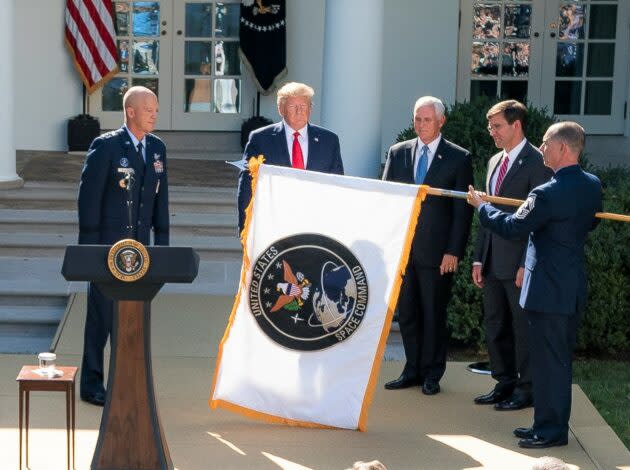Trump ushers in U.S. Space Command, with Space Force (or Corps) in the works

President Donald Trump today hailed the revival of the U.S. Space Command to protect America’s technological assets on the final frontier, and put in another pitch for the establishment of a U.S. Space Force as the sixth branch of the armed forces.
“This is a landmark day — one that recognizes the centrality of space to America’s national security and defense,” the president said.
“As the newest combatant command, SPACECOM will defend America’s vital interests in space — the next warfighting domain. And I think that’s pretty obvious to everybody. It’s all about space,” Trump declared during a White House Rose Garden ceremony that was also attended by Vice President Mike Pence, Defense Secretary Mark Esper and other officials.
“This is a landmark day — one that recognizes the centrality of space to America’s national security and defense,” the president said.
After Trump spoke, Esper signed the documents establishing the Space Command.
During meetings of the National Space Council, military experts have pointed to the challenges posed by China and Russia in the realms of hypersonic space vehicles and anti-satellite weapons, sparking the White House’s space defense plan.
The U.S. Space Command previously existed as a combatant command from 1985 to 2002, but it was folded into the U.S. Strategic Command during a post-9/11 reorganization of the military org chart.
Now the Space Command will once again coordinate space-related activities involving the five existing military branches — Air Force, Army, Navy, Marines and Coast Guard — with a focus on fields ranging from communications to missile detection and warning. Among the key assets to be defended are the Global Positioning System satellites, which have become essential for civilian scientific and commercial services as well as military operations.
Air Force Gen. Jay Raymond will head up the command, which is currently headquartered at Peterson Air Force Base in Colorado. At today’s ceremony, Raymond told Trump that “you honor the airmen, sailors, soldiers and Marines that secure our high ground for our nation.”
Trump said the unified combatant command would soon be followed by the establishment of the Space Force.
“That’s really something, when you think about it,” he said. “The Space Force will organize, train and equip warriors to support SPACECOM’s mission.”
When Trump gives speeches, his references to the Space Force are typically crowd-pleasers, but it’s not yet clear whether it’ll be called the Space Force.
The Space Command could be revived without a congressional go-ahead, but Congress has to approve the establishment of a new service branch. The House and the Senate have passed different versions of the required legislation, so negotiators will have to craft a compromise when Congress is back in session.
Both versions call for the branch to be created under the wing of the Department of the Air Force, just as the Marines exist as a separate branch under the wing of the Department of the Navy. The House version uses the term “Space Corps,” reflecting the parallel to the Marine Corps, while the Senate version sticks with “Space Force.”
The space activities conducted by NASA or intelligence agencies such as the National Reconnaissance Office wouldn’t come under the direct purview of the military. However, the acting director of national intelligence, Joseph Maguire, said during this month’s National Space Council meeting that the NRO would “take direction from the U.S. Space Command” in the event of a space-based conflict.
More from GeekWire:
VP Mike Pence details plan to create Space Force (sans starship troopers) by 2020
President Trump signs directive to create new Space Force under the Air Force’s wing
Trump authorizes revival of U.S. Space Command, with Space Force on agenda
Space Force plan moves forward amid heightened talk about final-frontier fights
